Menus
- The fight for the euro throne of the athletes
- Aprilia RSV4
- BMW S 1000 RR
- Ducati 1198 SP
- KTM 1190 RC8 R.
- MV Agusta F4
- 1st place: Aprilia RSV4 Factory APRC
- 2nd place: BMW S 1000 RR
- 3rd place: KTM 1190 RC 8R
- 4th place: Ducati 1198 SP
- 4th place: MV Agusta F4
- Aprilia RSV4 Factory APRC
- BMW S 1000 RR
- Ducati 1198 SP
- KTM 1190 RC8 R.
- MV Agusta F4
- Lap times Almeria
- Pirelli & Bike Promotion

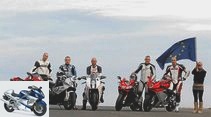
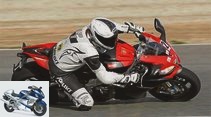
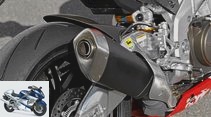
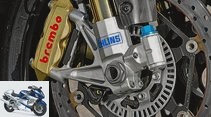
30th photos
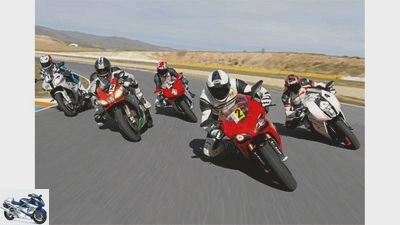
1/30
European motorcycle manufacturers are known to develop first-class super sports bikes. You can see the special features of these five bikes from MV Agusta, BMW, Ducati, KTM and Aprilia in the following pictures.
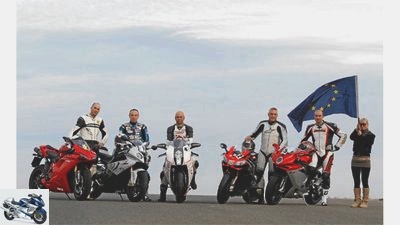
2/30
Well, which of these five bikes has earned the Euro throne?
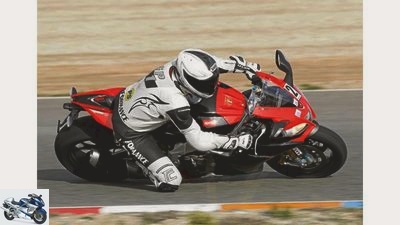
3/30
Maybe it is Aprilia’s unique new development: The RSV4 Factory APRC.
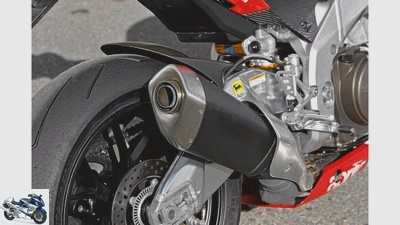
4/30
For the new electronic control of the exhaust flap, there was a new silencer for the RSV4.
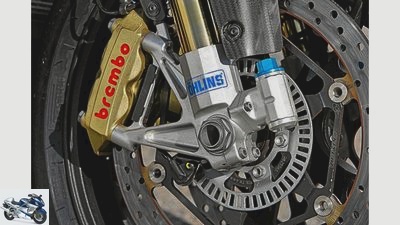
5/30
No ABS! The wreath informs the Aprilia’s APRC about the front wheel speed.

6/30
The clear speedometer of the Aprilia.
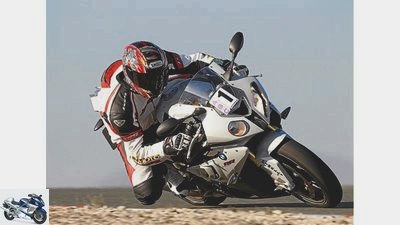
7/30
Although it is now a bike from last year, the BMW S 1000 RR is still quite tough.
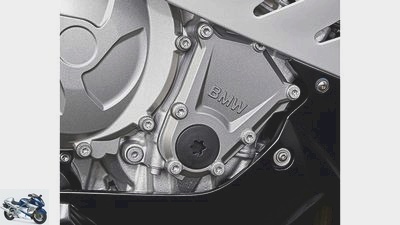
8/30
Nice torx. BMW screwdrivers need a well-stocked Torx range.

9/30
The BMW brake lever has a milled predetermined breaking point just in case.
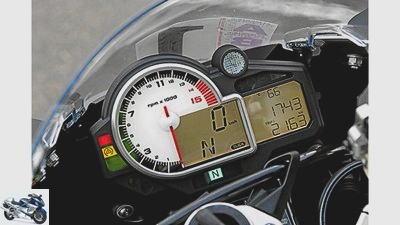
10/30
Practical and versatile: the speedometer of the S 1000 RR.
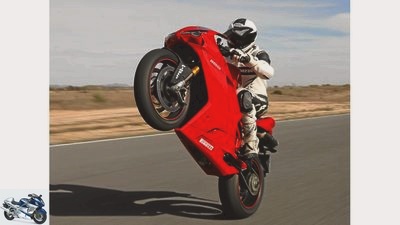
11/30
A classy athlete: the Ducati 1198 SP.
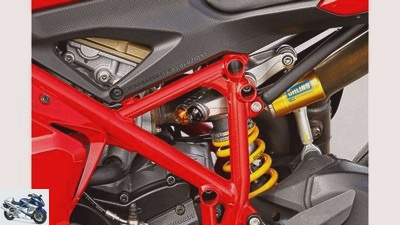
12/30
Thanks to the Ohlins TTX 36 shock absorber, the balance of the 1198 SP is improved.
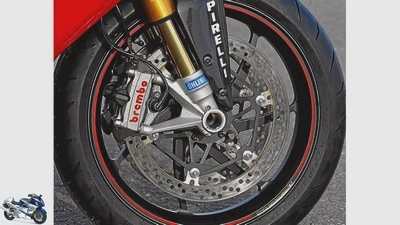
13/30
Still the most powerful brake on the floor: the Duc Brembos.
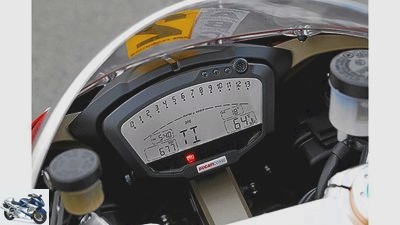
14/30
The Ducati speedometer is a bit unique.

15/30
The third Italian: the MV Agusta F4.
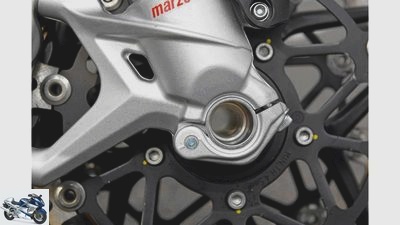
16/30
In the past, the MV was bursting with independence, the axle clamping testifies to that.
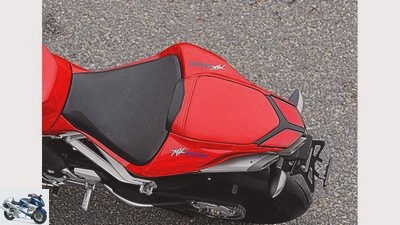
17/30
The rear of the MV F4 is also wide and expansive – and looks old.
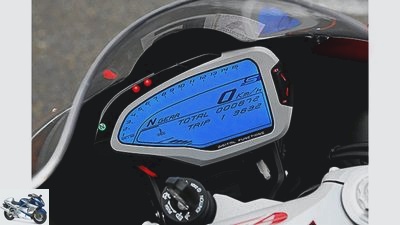
18/30
Stylish in blue: the speedometer of the MV Agusta.
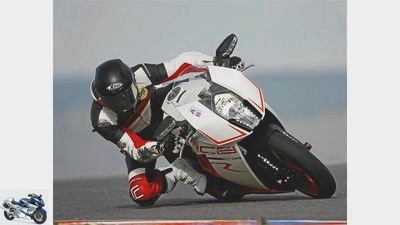
19/30
The new, improved version of the KTM RC8 R..

20/30
Adjustable eccentric, high and low speed compression and tension damping on the KTM shock absorber.
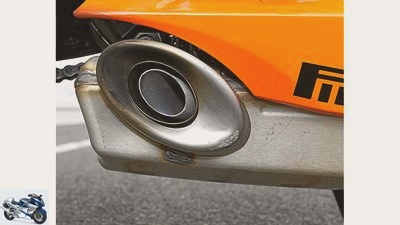
21/30
This has never been done before: a superimposed exhaust on the KTM 1190 RC 8R.
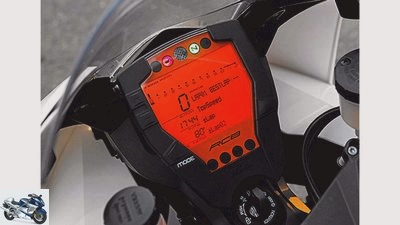
22/30
A very idiosyncratic, but not inferior speedometer at the KTM.

23/30
Five racers with strong character. The winner is not easy to determine.
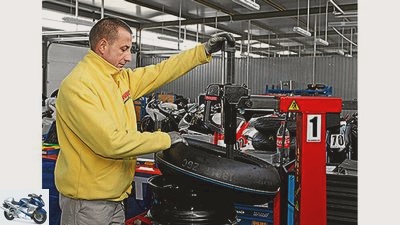
24/30
A special thank you goes to the Pirelli team, which sore fingers to get us the right tires.

25/30
The testers of the super athlete test: From Switzerland from Toff magazine: David Basler.

26/30
From PS: Our tester Robert Gluck.
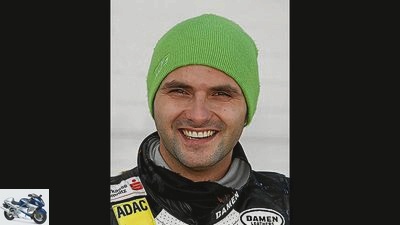
27/30
Also at the start for PS: the Moto2 racer Arne Tode.
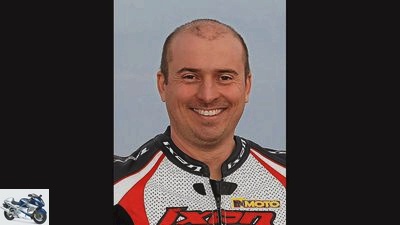
28/30
From the Italian motorcycle magazine IN MOTO: Francesco Gulinelli.
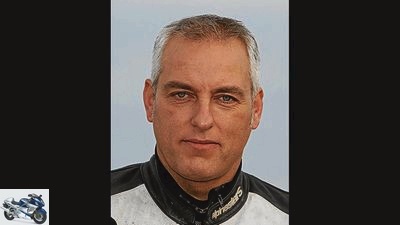
29/30
From our Belgian neighbors: Louis Wuyts from MOTORWERELD.
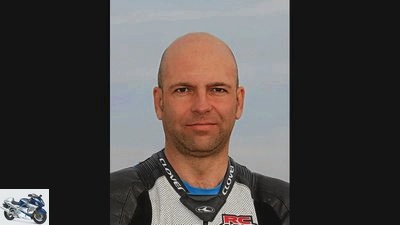
30/30
And last but not least: Luis Lopez from the Spanish magazine LA MOTO.
Track test: European superbikes
The fight for the euro throne of the athletes
Content of
The old continent is back in the superbike business with unprecedented power. Five manufacturers are fighting hard for the euro throne. Can the BMW S 1000 RR defend its crown??
Everything wasn’t better in the past. No, definitely not! Let’s just think back 15 years. Since the performance-oriented sports rider had to fall back on Japanese high-volume motorcycles without exception, in order to be able to gas properly. Okay, there were exotics like Bimota or acidic Ducatis like a 916 SPS or 996 SP. But for the average consumer, both European brands were simply not affordable. We don’t even want to talk about their reliability.
The world was already looking a lot friendlier in 2000: Aprilia’s RSV 1000-Twin proved to be extremely stable and reliable, D.Shortly thereafter, ucati followed suit with the durable and powerful Testastretta engines, and MV offered their 750 cc. And today? Similar to the EU, which has significantly increased the number of its member states in recent years, the number of European manufacturers in the sports segment has also grown significantly.
Today five different, characteristically independent Euro fighters cavort in the paddock of the Circuito de Almeria. A complete test field from three nations with three different engine concepts, three different cubic capacities on standard Pirelli spindles. Controlled by European test drivers who are competing to crown the 2011 European champions. The opponents: last year’s series winner from Germany, the BMW S 1000 RR, and the challengers from Austria and Italy in the form of the revised KTM 1190 RC 8R, the Aprilia RSV4 Factory APRC SE crammed with electronics, the upgraded Ducati 1198 SP and the unchanged MV Agusta F4 going into the year. Everyone is excited, the schedule is full and therefore very strict.
In the morning of the first day of testing, the focus is on setting up the chassis, which the in-house technicians do for the Aprilia, BMW, KTM and MV motorcycles. On the Pirelli Diablo Rosso Corsa, the testers are allowed to take the test drives from noon. Further test turns follow on the second day before the lap timing is due. Laptiming means: Moto2 rider Arne Tode pulls five laps on the cable on every motorcycle, each with the standard slick Pirelli Superbike in SC-2 mixture and the new dimension 200 / 60-17 tires. This is followed by further laps on the slicks for all test drivers.
Aprilia RSV4
Maybe it is Aprilia’s unique new development: The RSV4 Factory APRC.
A model name that is more complicated than the translated operating instructions for a Chinese DVD player: Aprilia RSV4 Factory APRC SE. Behind these cryptic abbreviations are on the one hand the major development step of the RSV4 for 2011, on the other hand the color variant. While SE or "Special edition" For the decor based on the successful World Championship Superbike, APRC (Aprilia Performance Ride Control) conceals a very comprehensive electronics package that is supposed to make the RSV4 Factory faster in amateur and professional hands. There is an eight-stage traction control (TC), a three-stage launch control, an anti-wheelie control (AWC) and an automatic gearshift. It is hardly surprising that your German driver’s manual includes an impressive 211 pages with all the electronic helpers. During the test, the TC levels 2 and 3, as well as the AWC in level 1. In general, the Aprilia, now two teeth shorter, seems to be tailor-made for the demanding course in Andalusia. It starts with the gear ratio that was perfect for Arne Todes’s hunt for lap times. At his high cornering speed, he can contest the entire infield in third gear in the optimal power range of the newly tuned engine.
For slower pilots, on the other hand, the speed drops a little too far, which then costs a few tenths from the apex. Nevertheless you can stay in third gear, save yourself using the automatic gearshift and beat the very appealing V4 around the track in its unique cloud of sound. Which is mainly due to the very linear power delivery of the V-engine. It never feels as strong as a bear, but there is always enough fat in every corner and in every aisle to fill you up and accelerate calmly. Not only does the TC help, which encourages the driver to accelerate earlier than usual. Above all, the high mechanical grip on the rear of the factory creates trust. For the hobby racer it feels like an eternity before he reaches the limit and the TC starts to work. If it is finally active, its control interventions are not felt as clearly as, for example, on the BMW. In addition, one has the impression that the Aprilia is slowed down less than the Bavarian due to its finer regulation.
The chassis of the APRC SE is an absolute stunner. Not only their playful handling, which almost turned nervous on the first day of testing on the Pirelli Diablo Rosso Corsa, is pleasing. Above all, their precision inspires. Regardless of whether you are rolling into the bends or firing from the apex under tension, the RSV4 always allows the line to be corrected or holds it without any effort. Only very hard opening of the throttle valve at a very low angle with the Pirelli Slick leads to the Italian being pushed slightly outwards. But this tendency is much weaker than that of the competition and always easy to correct. At one of the key points of the course, the extensive right-hand bend that opens onto the 900-meter-long straight, the APRC plays all its aces. The good responsiveness of the V4, its linear power delivery, the mechanical grip, the precision of the chassis and finally the TC ensure that the 20 hp weaker Aprilia loses just four km / h (272 to 276 km / h) top speed on the BMW . So it is no wonder that her racer virtues hit the nail on the head when chasing lap times and she posted the best time for herself.
BMW S 1000 RR
A bike from last year, but the BMW S 1000 RR is still quite tough.
A bitter pill for BMW, which made a brilliant start on the same track last year and, apart from new colors, will start the 2011 season unchanged. Which doesn’t have to be bad, after all, in 2010 the Bavarian dictated what happened in the world of athletes. But the BMW in 2011 in particular shows that things are now getting very tight for superbikes. As soon as you have got it in detail, it is already difficult to defend your title. On the one hand, the S 1000 RR received the first to be decided by lot "Launch site" In the lap time hunt, on the other hand, the Bavarians stood up against the suspension set by the BMW confidante, multiple 250cc European champion Alvaro Molina. The fork, which was fully pre-tensioned by Molina, ensured good braking stability, but it cost time when accelerating out, because the motorcycle made a wide arc and thus had to be kept on the desired line with force.
The criticism of the BMW, which was already noted in 2010, caused further annoyance in 2011: The pressure point of the brake shifts. On the other hand, we liked the romp of the aggressive four-cylinder, which even sniffed the eternally long straight in no time. The perfectly coordinated automatic gearshift helps him to change gears safely and quickly. In the infield garnished with three blind corners, however, the automatic gearshift is free, and this section of the route is also driven in third gear on the BMW. At least Moto2-Racer Tode gets along well with it, although compared to the other four-cylinder engines from Aprilia and MV Agusta he misses traction: "For me, the four-wheeled BMW between 6000 and 9000 tours simply has too little pressure." The author, who compared to death lacked cornering speed and therefore also lacked momentum when accelerating out, managed to drive everything in second gear. The S 1000 RR then roars like on a spit, but thanks to the traction control, revs over 10,000 rpm in an inclined position cannot really be frightening.
Ducati 1198 SP
A classy athlete: the Ducati 1198 SP.
These speeds would not only frighten the Ducati, they would break it apart. So it’s good that the twin from Bologna delivers fat pressure in the middle and upper speed range. This means that both professional and hobby racers can unwind the infield in third gear. Which is actually a shame, because the 1198 SP is also equipped with a well-functioning automatic switch. And that’s not the only goodie they have "SP" from last year’s "S."-Version differs. Despite the 2.5 liter higher volume, the 18 liter aluminum tank saves weight, the anti-hopping clutch from the "R."-Version prevents annoying rear wheel stamping when braking, and the Ohlins TTX 36 shock absorber is much more sensitive to the rear of the Ducati. One can really speak of a successful revision. Especially when it turns out after the first few laps on the 1198 SP that the TTX shock absorber is not only more sensitive than the shock absorber of the predecessor, but also corrects the entire balance of the Duc. Finally it compresses synchronously on the front and rear wheels and provides a very stable driving experience. But only on the Pirelli Slick. The 1198 SP did not harmonize with the Pirelli Diablo Rosso Corsa installed on the first day of testing. Although the rubber gives it a handiness that has never been experienced, a lot of feedback is lost due to the almost resistance-free folding down in an inclined position. So there was no real feeling for the front wheel.
When the concentrated twin power is fired from the apex, there is some movement in the booth. The basic setting reaches its limits, but gives a good driving experience. Completely unsurprisingly, the 1198 SP generates this irresistible Ducati driving experience on the slicks: with full feedback and this feeling of invulnerability, it burns through the tight bends and fast arcs. Unfortunately – also typical for Duc – she needs a strong hand for jagged changes of direction, and her gearbox has to be operated with vigor when downshifting. Two traditions that Ducati could slowly break with.
KTM 1190 RC8 R.
The new, improved version of the KTM RC8 R..
The Ducatisti can learn from KTM how to break with unpleasant traditions. The gearboxes of earlier RC-8 models were more of a nuisance than a source of joy, but that has definitely changed in 2011. The new KTM enables precise and smooth gear changes, only causing annoyance to time burner Arne Tode because of the gear ratio that was not quite suitable for Almeria. The second course was too short for him and the third gear was too long. This is called whining at a very high level, after all, with one exception, there is nothing to complain about with the current RC 8R. But this is so special that it even amazed the KTM product manager Jorg Schuller and ex-MotoGP and KTM test rider Jeremy McWilliams who were present. The KTM hit the muffler in right-hand bends during compression. A result of two factors. On the one hand, Arne Tode is used to driving extreme lean angles, on the other hand, the huge Pirelli slick in size 200 / 60-17 requires and enables these brutal lean angles. Because the wider a tire, the more lean angle it needs to get through the curve. In the test field, the KTM was the only one that had such problems.
Apart from that, the Austrian is a real weapon. It is more manageable than the Ducati – although it now has to do without the expensive and light forged wheels of recent years – and is almost as full as the MV Agusta. In the twisted infield, her very good feedback and the precision with which she dances through the curves are convincing.
Their merciless price is also remarkable. Hardly calculated, it is the bargain among the five Euro fighters. On the other hand, it lacks the very development-intensive and expensive equipment features such as traction control, ABS or even an automatic gearshift. If you don’t need these gadgets, you can of course access the KTM without hesitation. Nevertheless, it is obvious that there is a gap here compared to the competition. And the two competitors placed in front of her prove how much well-adapted electronic helpers can bring.
MV Agusta F4
The third Italian: the MV Agusta F4.
Like the KTM, the third Italian in the group is equipped with relatively conventional equipment. In other words, it only offers traction control as an assistance system. However, this acts highly questionable. While Aprilia, BMW and Ducati allow slides and sometimes catch them at an alarmingly late stage for hobby drivers, the MV does not have the feeling that there is any regulation at all. Our Italian colleague Francesco Gulinelli can tell you a lot about it. With his buttocks high in the air and his feet off the pegs, he found himself coming out of the last bend on the start-finish straight. A worth seeing, but ungrateful stunt. From this point of view, KTM would do well not to use a TC as long as no really effective system is available.
But back to the MV: It was already able to impress on the racetrack at last year’s Masterbike. And it is not surprising that its combination of strong, linearly pressing four-cylinder and superb stability scores in Almeria. Similar to the Ducati, it does require a specific steering impulse to get out of the central position. But as soon as it is inclined on the tire flank, its crisp and crisp transparency scores. Your chassis forwards all information from the tires to the driver, holds the line perfectly and does not buckle at the rear even under load. It gives a lot of confidence, the driver feels good and the lap time is dropping.
At the MV, too, the professional rider Tode prefers third gear for the fast lap, while the amateur racer stays in second. Despite the steady development of power, it lacks speed when exiting a corner. A shortcoming that simply sticks to the four-cylinder with a pilot that is too slow, but can be corrected with a slightly shortened secondary ratio.
Conclusion: The European Champion 2011 has been chosen! The Aprilia APRC wins among the five racers with strong character and takes the powerful BMW S 1000 RR from the throne. The revised KTM 1190 RC 8R lands in third place without assistance systems, just ahead of the Ducati 1198 SP and the MV Agusta F4. Congratulations to everyone involved, it doesn’t get any closer.
1st place: Aprilia RSV4 Factory APRC
The clear speedometer of the Aprilia.
Category drive:
The new engine electronics including traction control and automatic gearshift, as well as the shorter gear ratio, give wings. The e-gas can now be dosed very finely.
5 out of 5 stars
Category chassis:
The absolute hammer! Super handy, stable and precise, the Aprilia bests burns on the asphalt. She is still a bit restless on the brakes.
5 out of 5 stars
Category ergonomics:
There is a deduction for the exclusion of large pilots who have to fold up too much. Racing gnomes, on the other hand, find a perfect workplace.
4 out of 5 stars
Category driving fun:
It’s amazing on the slopes. The APRC is a real hit and is more fun with every lap. The revision was definitely worth it.
5 out of 5 stars
Category PS judgment:
Thanks to the best suspension, great electronics, powerful engine, good equipment and fastest lap time, the Aprilia climbs to the European throne.
19 out of 20 stars
2nd place: BMW S 1000 RR
Practical and versatile: the speedometer of the S 1000 RR.
Category drive:
As soon as the BMW burns down its fireworks, there is no stopping it. The acceleration orgy is supported by the perfectly operating gearshift.
5 out of 5 stars
Category chassis:
Their dampers are not on par with the Aprilia. In addition, a rather strange setup cost the S 1000 RR the fastest lap in lap timing.
4 out of 5 stars
Category ergonomics:
Space for young and old on the Bayerin. Only the windshield is a bit too tight, which means that the wind protection is poor. Otherwise everything was great.
4 out of 5 stars
Category driving fun:
It burns like a hot knife through butter on the straight through the starting field. Your thrust from 9000 / min is an endorphin fireworks display.
5 out of 5 stars
PS judgment:
Last year’s queen has to bow to a brilliant Aprilia. But the BMW is still the most fascinating "engine"-Bike among the super athletes.
18 out of 20 stars
3rd place: KTM 1190 RC 8R
A very idiosyncratic, but not inferior speedometer at the KTM.
Category drive:
No traction control, but a perfectly controllable gas. The 2011 engine has become smoother and more powerful, and the transmission now shifts well and precisely.
4 out of 5 stars
Category chassis:
Although a little more unwieldy than the Aprilia, the KTM still shines with real racer genes. However, there is a deduction for the lack of lean angle.
4 out of 5 stars
Category ergonomics:
Different, but good. Anyone who gets on the RC 8R has to get used to it, but is very comfortable. The feet are in because of the deep notches "Grinding hazard".
4 out of 5 stars
Category driving fun:
The KTM also benefits from its massive engine revision and is now fun on the slopes and on the road. Subjectively, the twin could be more aggressive.
4 out of 5 stars
PS judgment:
The orange is a character actress and thanks to the fine-tuning of the most important points of criticism, she fought for a great third place.
16 out of 20 stars
4th place: Ducati 1198 SP
The Ducati speedometer is also a bit unique.
Category drive:
A standard anti-hopping clutch and traction control upgrade the power twin. Her brutal boost from 7000 tours is still awesome.
4 out of 5 stars
Category chassis:
Thanks to the Ohlins TTX 36 shock absorber in the rear, the balance is much better. The Duc still needs a clear steering impulse to turn.
4 out of 5 stars
Category ergonomics:
With its pronounced seat pan and a lot of pressure on the wrists, the 1198 SP may look sporty, but it is also strenuous for the pilot in the long run.
3 out of 5 stars
Category driving fun:
"Yes, we can" seems to want to say Bologna with the SP. The more harmonious setup and the AHK increase driving pleasure by 100 percent.
4 out of 5 stars
PS judgment:
Since the competitors have also stepped up, the Ducati only comes in fourth. Nevertheless, it is the best superbike of the 1098/1198 generation to date.
15 out of 20 stars
4th place: MV Agusta F4
Stylish in blue: the speedometer of the MV Agusta.
Category drive:
The MV goes linearly and with bold pressure. Your long final translation dampens the joy a bit, and the traction control is not completely convincing.
4 out of 5 stars
Category chassis:
It is not really handy, but it is neutral and ultra-stable in an inclined position. As if on rails, she nails through curves of all kinds and inspires her pilot.
4 out of 5 stars
Category ergonomics:
Despite the improvement over the predecessor, the driver is still sitting stretched out on the F4. Their short stops are a bit slippery and the windbreak is just about missing.
3 out of 5 stars
Category driving fun:
Take the MV by the horns and you have fun with her. The faster it gets, the more comfortable the F4 feels, the more it gives back to its rider.
4 out of 5 stars
PS judgment:
The lap time shows: The F4 is lightning fast on the slopes. Translated a little shorter and with a more compact seating position, she would be victorious.
15 out of 20 stars
archive
The performance diagram of the super athlete.
The intimate unity among couples would be there without the BMW. The four-cylinder MV and Aprilia cuddle their curves nicely together, as do the twin KTM and Ducati. But as it is, the high-flyer BMW breaks the picture, surpasses the performance curve of the others from 10 500 tours. It is astonishing that, despite its enormous top-end power, it loses nothing in terms of torque against the Italian four-cylinder. The Twins, on the other hand, not only reach their maximum torque 2000 revs earlier, but also add a maximum of at least ten Newton meters. respect!
Aprilia RSV4 Factory APRC
For the new electronic control of the exhaust flap, there was a new silencer for the RSV4.
drive:
Four-cylinder 65-degree V-engine, 4 valves / cylinder, 132 kW (180 PS) at 12,500 / min *, 115 Nm at 10,000 / min *, 1000 cm³, bore / stroke: 78.0 / 52, 3 mm, compression ratio: 13.0: 1, ignition / injection system, 48 mm throttle valves, mechanically operated multi-disc oil bath anti-hopping clutch, six-speed gearbox, G-Kat
landing gear:
Light alloy bridge frame, steering head angle: 65.5 degrees, caster: 105 mm, wheelbase: 1420 mm. Upside-down fork, Ø fork inner tube: 43 mm, adjustable in spring base, rebound and compression. Central spring strut with deflection, adjustable in spring base, length, rebound and compression stage, spring travel front / rear: 120/130 mm
Wheels and brakes:
Forged alloy wheels, 3.50 x 17"/6.00 x 17", Front tires: 120/70 ZR 17, rear: 190/55 ZR 17. Test tires: Pirelli Diablo Rosso Corsa. 320 mm double disc brake with four-piston fixed callipers at the front, 220 mm single disc with two-piston fixed calliper at the rear
Measurements and weight:
Length / width / height: 2050/750/1130 mm, seat / handlebar height: 845/865 mm, handlebar width: 665 mm, 204 kg fully fueled, v./h .: 50.5 / 49.5%
Rear wheel power in last gear:
120.5 kW (164 PS) at 269 km / h
Performance:
Acceleration 0-100 / 150/200 km / h: 3.2 / 5.0 / 7.6 s
Pulling speed 50-100 / 100-150 km / h: 4.6 / 4.2 s
Top speed: 295 km / h *
consumption:
Fuel type: Super unleaded. Average test consumption: n / a, tank capacity: 17 liters, range: n / a.
Base price: 22 490 Euro (plus ancillary costs)
BMW S 1000 RR
Nice torx. BMW screwdrivers need a well-stocked Torx range.
drive:
Four-cylinder in-line engine, 4 valves / cylinder, 142 kW (193 hp) at 13,000 / min *, 112 Nm at 9750 / min *, 999 cm³, bore / stroke: 80.0 / 49.7 mm, compression ratio: 13, 0: 1, ignition / injection system, 48 mm throttle valves, mechanically operated multi-disc oil bath anti-hopping clutch, six-speed gearbox, G-Kat, chain
landing gear:
Light alloy bridge frame, steering head angle: 66.1 degrees, caster: 96 mm, wheelbase: 1432 mm, upside-down fork, Ø fork inner tube: 46 mm, adjustable spring base, rebound and compression level. Central spring strut with deflection, adjustable in spring base, rebound and compression level (high / low), spring travel front / rear: 120/130 mm
Wheels and brakes:
Light alloy cast wheels, 3.50 x 17"/6.00 x 17", Front tires: 120/70 ZR 17, rear: 190/55 ZR 17, test tires: Pirelli Diablo Rosso Corsa, 320 mm double disc brake with four-piston fixed calipers at the front, 220 mm single disc with single-piston floating caliper at the rear
Measurements and weight:
Length / width / height: 2080/785/1110 mm, seat / handlebar height: 810/865 mm, handlebar width: 660 mm, 208 kg fully fueled, v./h .: 52.0 / 48.0%
Rear wheel power in last gear:
137.5 kW (187 hp) at 282 km / h
Performance:
Acceleration 0-100 / 150/200 km / h: 3.1 / 5.0 / 7.0 s
Draft 50-100 / 100-150 km / h: 4.3 / 4.1 s
Top speed: 299 km / h *
consumption:
Fuel type: Super unleaded. Average test consumption: 9.0 liters / 100 km, tank capacity / of which reserve: 17.5 / 4 liters, range: 194 km
Base price: 15,500 euros (plus ancillary costs, special paint 475 euros, shift assistant 360 euros, Race ABS + DTC 1220 euros)
Ducati 1198 SP
Thanks to the Ohlins TTX 36 shock absorber, the balance of the 1198 SP is improved.
drive:
Two-cylinder 90-degree V-engine, four valves / cylinder, 125 kW (170 PS) at 9750 / min *, 131 Nm at 8000 / min *, 1198 cm³, bore / stroke: 106.0 / 67.9 mm , Compression ratio: 12.7: 1, ignition / injection system, 64 mm throttle valves, hydraulically operated multi-plate dry anti-hopping clutch, six-speed gearbox, G-Kat
landing gear:
Steel tubular space frame, steering head angle: 65.5 degrees, caster: 97 mm, wheelbase: 1430 mm, upside-down fork, Ø fork inner tube: 43 mm, adjustable in spring base, rebound and compression. Central spring strut with deflection, adjustable in spring base, rebound and compression. Suspension travel front / rear: 127/127 mm
Wheels and brakes:
Forged alloy wheels, 3.50 x 17"/6.00 x 17", Front tires: 120/70 ZR 17, rear: 190/55 ZR 17, test tires: Pirelli Diablo Rosso Corsa, 330 mm double disc brakes with four-piston fixed calipers at the front, 245 mm single discs with two-piston fixed calipers at the rear
Measurements and weight:
Length / width / height: 1080/810/1100 mm, seat / handlebar height: 810/860 mm, handlebar width: 675 mm, 197 kg fully fueled, v./h .: 49.9 / 50.1%
Rear wheel power in last gear:
116 kW (158 PS) at 264 km / h
Performance:
Acceleration 0-100 / 150/200 km / h: 3.2 / 5.3 / 8.0 s
Pulling speed 50-100 / 100-150 km / h: 5.0 / 4.1 s
Top speed: 288 km / h *
consumption:
Fuel type: Super unleaded. Average test consumption: n / a, tank capacity 18 liters, range: n / a.
Base price: 22 690 euros (plus additional costs)
KTM 1190 RC8 R.
Adjustable eccentric, high and low speed compression and tension damping on the KTM shock absorber.
drive:
Two-cylinder 75-degree V-engine, 4 valves / cylinder, 125 kW (170 PS) at 10 250 / min *, 123 Nm at 8000 / min *, 1195 cm3, bore / stroke: 105.0 / 69.0 mm, compression ratio: 13.5: 1, ignition / injection system, 52 mm throttle valves, hydraulically operated multi-plate oil bath clutch, six-speed gearbox, G-Kat
landing gear:
Steel tubular space frame, steering head angle: 66.7 degrees, caster: 96 mm, wheelbase: 1425 mm. Upside-down fork, Ø fork inner tube: 43 mm, adjustable in spring base, rebound and compression. Central spring strut with deflection, adjustable in spring base, rebound and compression. Spring travel v./h .: 120/120 mm
Wheels and brakes:
Light alloy cast wheels, 3.50 x 17"/6.00 x 17", Front tires: 120/70 ZR 17, rear: 190/55 ZR 17. Test tires: Pirelli Diablo Rosso Corsa. 320 mm double disc brake with four-piston fixed callipers at the front, 220 mm single disc with two-piston fixed calliper at the rear
Measurements and weight:
Length / width / height: 2050/830/1110 mm, seat / handlebar height: 810/880 mm, handlebar width: 665 mm, 204 kg with a full tank, v./h .: 52.8 / 47.2%
Rear wheel power in last gear:
115 kW (156 PS) at 266 km / h
Performance:
Acceleration 0-100 / 150/200 km / h: 3.2 / 5.2 / 7.9 s
Pulling speed 50-100 / 100-150 km / h: 4.7 / 4.5 s
Top speed: 287 km / h *
consumption:
Fuel type: Super unleaded. Average test consumption: k. A., tank capacity 16.5 liters, range: ns. A..
Base price: 16 295 Euro (plus utilities)
MV Agusta F4
In the past, the MV was bursting with independence, the axle clamping testifies to that.
drive:
Four-cylinder in-line engine, four valves / cylinder, 137 kW (186 HP) at 12,900 / min *, 114 Nm at 9500 / min *, 998 cm3, bore / stroke: 76.0 / 55.0 mm, compression ratio: 13, 1: 1, ignition / injection system, 49 mm throttle valves, hydraulically operated multi-disc oil bath anti-hopping clutch, six-speed gearbox, chain, G-Kat
landing gear:
Steel tubular space frame, steering head angle: 66.5 degrees, caster: 100 mm, wheelbase: 1430 mm, upside-down fork, Ø fork inner tube: 50 mm, adjustable in spring base, rebound and compression level. Central spring strut with deflection adjustable in spring base, rebound and compression stage, spring travel front / rear: 120/120 mm
Wheels and brakes:
Light alloy cast wheels, 3.50 x 17"/6.00 x 17", Front tires: 120/70 ZR 17, rear: 190/55 ZR 17, test tires: Pirelli Diablo Rosso Corsa, 320 mm double disc brake with four-piston fixed calipers at the front, 210 mm single disc with four-piston fixed caliper at the rear
Measurements and weight:
Length / width / height 2070/790/1090 mm, seat / handlebar height 840/845 mm, handlebar width 695 mm, 214 kg fully fueled, f / r 51.9 / 48.1%
Rear wheel power in last gear:
121.3 kW (165 PS) at 275 km / h
Performance:
Acceleration 0-100 / 150/200 km / h 3.3 / 5.2 / 7.5 s
Pulling speed: 50-100 / 100-150 km / h 5.9 / 4.6 s
Top speed: 305 km / h *
consumption:
Fuel type: Super unleaded. Average test consumption: n / a, tank capacity 17 liters, range: n / a.
Base price: 18 500 euros (plus ancillary costs)
Lap times Almeria
archive
The route from Almeria – route length: 4025 meters.
| Driver: Arne Tode | Lap time in minutes: | Section 1 | Section 2 | Section 3 | Section 4 | Ideal lap time * | Top speed | Aprilia RSV4 Factory APRC | 1.42.75 | 32.14 s | 23.58 s | 15.04 s | 31.99 s | 1.42.58 | 272 km / h |
| MV Agusta F4 | 1.43.27 | 32.42 s | 23.61 s | 15.10 s | 32.14 s | 1.43.21 | 272 km / h | BMW S 1000 RR | 1.44.21 | 32.47 s | 24.14 s | 15.44 s | 32.16 s | 1.44.07 | 276 km / h |
| KTM 1190 RC 8R | 1.44.22 | 32.63 s | 23.74 s | 15.23 s | 32.62 s | 1.44.22 | 263 km / h | Ducati 1198 SP | 1.44.37 | 32.69 s | 23.75 s | 15.32 s | 32.61 s | 1.44.30 | 261 km / h |
* Sum of the best sectors
| Driver: Arne Tode | Lap time in minutes: | Backlog motorcycle | Backlog amateur | Aprilia RSV4 Factory APRC |
1.42, 75 | – | +4.16 s |
| MV Agusta F4 | 1.43.27 | +0.52 s | +4.14 s | BMW S 1000 RR | 1.44.21 | +1.46 s | +2.65 s |
| KTM 1190 RC 8R | 1.44.22 | +1.47 s | +3.42 s | Ducati 1198 SP | 1.44.37 | +1.62 s | +3.51 s |
Pirelli & Bike Promotion
A special thank you goes to the Pirelli team, which sore fingers to get us the right tires.
Our thanks go to Pirelli and Bike Promotion in particular. Without these partners, the major international comparative test in southern Spain would not have taken place. Pirelli provided two sets of Diablo Rosso Corsa per motorcycle for test and photo rides and one set of the new Diablo Superbike slicks in SC 2 compound for each lap time. Bike Promotion under the direction of Thomas Thieme integrated the test drives and photo shoots as well as the lap timing perfectly into an ongoing race training, while the mechanic, mechanic and tire professional Marcel got his fingers sore.
Related articles
-
Comparison test: Epochal motorcycles
fact 9 pictures fact 1/9 Honda CBR 900 RR Fireblade: Back then and now a nuisance: The idiosyncratic 16-inch front wheel worsens handling with …
-
Comparison test: Ducati 1198 S against Ducati Multistrada 1200 S
Jahn Comparison test: Ducati 1198 S against Ducati Multistrada 1200 S Ducati 1198 S versus Ducati Multistrada 1200 S Content of One brand, one engine,…
-
Comparison test: power naked bikes on the racetrack
Comparison test: Naked bikes on the racetrack Country road fighters on the racetrack It has to be extreme content – this shows what …
-
Comparison test of naked bikes
Naked bike comparison test 2011: Ducati, Kawasaki and Triumph The triumph of the new Speed Triple content from Triumph strikes back. After this…
-
Comparison test: mid-range fun bikes
fact comparison test: Aprilia, Ducati, Kawasaki, KTM mid-range funbikes in comparison Content of games, fun and excitement promises a comparison test …
-
BMW, Ducati, Suzuki and Triumph super sports cars in a comparison test
29 photos 1/29 Triumph Daytona 675, Ducati 848 Evo Corse SE, BMW S 1000 RR, Suzuki GSX-R 750. Different bikes – different cubic…
-
Comparison test: Honda CB 1000 R, Yamaha FZ1, Triumph Speed Triple, Kawasaki Z 1000
Comparison test: Honda CB 1000 R, Yamaha FZ1, Triumph Speed Triple, Kawasaki Z 1000 Large naked bikes in comparison Contents of …
-
Comparison test: MV Agusta Brutale 1090 RR and Ducati Streetfighter S
fact comparison test: Italian naked bikes, Ducati Streetfighter S, MV Agusta Brutale 1090 RR MV Agusta Brutale 1090 RR and Ducati Streetfighter S …
-
Comparison test: superbikes on the country road
Jahn 23 pictures Aprilia 1/23 Max Biaggi has already achieved some successes in the Superbike World Championship with his Aprilia RSV4. Aprilia 2/23 Aprilia 3/23 …
-
Comparison test: Superbikes 2012
32 pictures 1/32 Yamaha YZF-R1, MV Agusta F4 RR, Kawasaki ZX 10-R, BMW S 1000 RR and Honda Fireblade C-ABS in the super sports car …